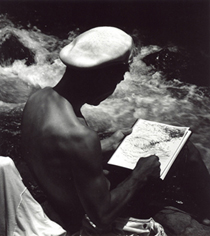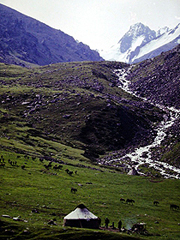TADAMASA YOKOYAMA :PAINTINGS
BIOGRAPHY

- TADAMASA YOKOYAMA -
1991 In Borneo
photo© Kazuhiko Sonoki
TADAMASA YOKOYAMA
:PAINTINGS
- Producer
Mami Sasaki - Art Direction and Design
Atsuya Ishikawa - Text
Tadamasa Yokoyama
Ή@Oη - Translation
John Barrett (English)
Sylvia Lorrain (French)
Kirill Krasovskiy (Russian)
Halim Karabibene (Arab)
Hsuan-Yeh Fu (Chinese) - Photography
Kazuhiko Sonoki - I would like to thank
Mami Aoi
Keiko Yoshikawa - Special Thanks
Hiroshi Morinaga
Akiyoshi Kawaguchi
Tetsuji Kasuya
Gen Tarumi
John Barrett
Takeo Komatsu
Kiyoko Nishifuji
Shuichi Seiyama
Hideki Koide
Yumiko Aoki
Kazuo Kawabata
Tomoyasu Hotei
Toshihisa Okabe
Akemi
Yasuko Hirose
Kiyokazu Nakajima
Katsu Nagaishi
Naoe Tamari
Tadashi Yokoyama
Yasuko Motomatsu
Hisae Katou
Kaoru Matsuyama
Masayuki Yamazaki
Kyu Seigen
Akane Inagaki
Nonoko
Cosmoses and Beyond
Born in 1951 among the rugged foothills of Yamagata prefecture in northern Japan, Tadamasa Yokoyama' s formative years were steeped in the Japanese traditional arts. His father was a Shodo(calligraphy) teacher while his mother was devoted to Ikebana traditional flower arrangements. From an early age Yokoyama was intimately acquainted with nature as the fields surrounding his home were strewn with wild flowers throughout the seasons.
Yokoyama's dedication to flowers and painting has endured more than four decades. As a child he would sketch the world around him until one day he decided to paint a peony only to realise that it didn't bloom in the manner he supposed. It had a mysterious, intangible quality that escaped realistic description. While over the centuries numerous painters have chosen flowers as a motif for their work, the bulk of them treated them merely as a decorative element in the scenery. Yokoyama perceives them otherwise: flowers remain the apple of his eye, breathing, exuding the mystery of life itself.
From the outset Yokoyama's approach has been to unearth a flower's innate qualities. Like the explorers of old, he delves through its each and every aspect: its botanical features, its cultural and philosophical references along with the nature of its habitat. This process involves many twists and turns: the garden path from the initial awakening of interest to the coming to light on canvas in his Tokyo atelier winds through many hidden corners. On occasion he paints in situ with canvas and easel; at other times he works from a photographic representation of the flower, often than taken by himself. His choice of flower, or the vase in which he places it, is never incidental. His exploration is an on-going process, of moving from one terrain to the next, from one genus to another. His world has dramatically altered since his childhood: back then nobody gave a second thought about picking the wild flowers abloom in the fields. Nowadays it has almost become a criminal act.
In an evolutionary context, flowers as a biological specimen predate the human race. Homo sapiens are relatively recent arrivals, representing but a speck in the planet's chronological evolution. Yet in that short space of our existence we are doing our utmost to exterminate the botanical diversity that has existed since time immemorial in this, what Yokoyama refers to, flower planet. In essence, Yokoyama's work represents a paean to the perseverance of flowers in such an inhospitable world. For him, our world would be truly inconceivable without flowers. Wherever civilisation has prospered, flowers have invariably played a significant role in cultural evolution, over time becoming ubiquitous symbols of love, happiness and peace. From the various archaeological studies and digs carried out throughout the world, it is clear that flowers have been a constant presence in our daily lives. Traces of flowers have been found in the burial mounds of our most distant ancestors. Flower pollen was discovered in the depths of the Babylonian caves where flowers adorned the final resting place of local tribes people.
The seed scattering winds have in equal measure activated new forms of life in new habitats flowers while stimulating minds. The founder of the Noh theatre Zeami believed that we should come to realise the flower within ourselves. As with human beings, a flower lives through the seasons of life, each with its intrinsic beauty. The duty of an artist is to grasp this inner truth. Human beings, as Yokoyama sees it, are but one species in the entire spectrum of biological evolution. Our human focused perspective blinds us to this fact that we are but a minute part in this vast whole. In his attempt to encapsulate the inner beauty of each flower on canvas, of leaving a visual trace for eternity, Yokoyama hopes at the very least that he can help enlighten us concerning life's mystery.













